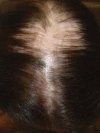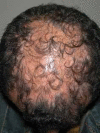Lichen planopilaris epidemiology: a retrospective study of 80 cases
- PMID: 26560212
- PMCID: PMC4631232
- DOI: 10.1590/abd1806-4841.20153923
Lichen planopilaris epidemiology: a retrospective study of 80 cases
Abstract
Background: Lichen planopilaris is a frequent presentation of primary cicatricial alopecia. Scalp distribution characterizes the main clinical presentations: classic lichen planopilaris, frontal fibrosing alopecia and Graham-Little Piccardi-Lassueur Syndrome (GLPLS).
Objective: Description of the clinical, dermoscopic and histopathological findings of Lichen planopilaris in public and private practices.
Method: A retrospective observational study was performed by reviewing medical records of patients with lichen planopilaris.
Results: Eighty patients were included, 73 (91,25%) were female. Prototype II was seen in 53 (66,25%) patients. Classic lichen planopilaris was seen in 62,5% of the cases. Frontal fibrosing alopecia was seen in 31% of the patients and only one patient presented Graham-Little Piccardi-Lassueur Syndrome (GLPLS). Scalp lesions were scattered throughout the scalp in 47 (58,75%) of the patients, while 24 (30%) presented mainly central scalp lesions, 29 (36,25%) presented marginal lesions and only 4 (5%) patents had vertex lesions.
Conclusions: Clinical presentation of Lichen planopilaris varies. To recognize the heterogeneity of the clinical appearance in lichen planopilaris is important for differential diagnosis.
Conflict of interest statement
Conflict of Interest: None.
Figures



References
-
- Assouly P, Reygagne P. Lichen Planopilaris: Uptade on Diagnosis and Treatment. Semin Cutan Med Surg. 2009;28:3–10. - PubMed
-
- Kang H, Alzolibani AA, Otberg N, Shapiro J. Lichen planopilaris. Dermatol Ther. 2008;21:249–256. - PubMed
-
- Samrao A, Chew AL, Price V. Frontal Fibrosing alopecia: a clinical review of 36 patients. Br J Dermatol. 2010;163:1296–1300. - PubMed
-
- Zegarska B, Kallas D, Schwartz RA, Czajkowski R, Uchanska G, Placek W. Graham-Little Syndrome. Acta Dermatovenerol Alp Pannonica Adriat. 2010;19:39–42. - PubMed
-
- Abbas O, Chedraoui A, Ghosn S. Frontal fibrosing alopecia presenting with components of Piccardi-Lassueur-Graham-Little syndrome . J Am Acad Dermatol. 2007;57:S15–S18. - PubMed
MeSH terms
LinkOut - more resources
Full Text Sources
Other Literature Sources
